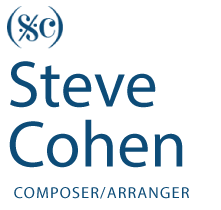Long story short: I grew up in a secular household, and came to religion very late in life, in my forties. What brought me in was the music. Not the bland folk-rock they played for family services, but the real music. Sitting in the sanctuary during the High Holy Days, I marveled at the power and depth of such pieces as Janowski’s Avinu Malkeinu and Helfman’s Sh’ma Kolienu. These and other pieces of similar quality made me decide to start writing my own musical settings of biblical and liturgical texts.
I believe that when a composer sets a sacred text to music, that composer is writing a midrash, a commentary and interpretation. Ideally, the musical setting adds meaning to the text, and expresses in music what cannot be conveyed only with words. Just as an illuminated manuscript adds visually to the text, the music should add and enrich the text with sound.
When I set a Psalm or a prayer to music, my first step is to analyze the text, to fully understand its structure and meaning. I feel it’s best not to approach the text with pre-conceived musical ideas; the musical ideas should stem from the words of the text.
During Yom Kippur, the Day of Atonement, the congregation recites the Vidui, the communal confession of sins. One translation of this list refers to “the sin of distorting facts to fit our theories,” and hearing this phrase spoken prompts a little voice in my head to add, “and the sin of distorting texts to fit our melodies.”
The composer should have a deep understanding of the stresses of the text, which words within the phrase are the important ones, and which syllables within the words are stressed. It’s always a bad practice to put the em-PHA-sis and the wrong syl-LA-ble, and this is a most egregious sin when the text being set to music is one we should hold in the greatest reverence.
Unfortunately, I see and hear such carelessness or ignorance way too often in the music that’s currently most popular in Reform Judaism.
Case in point: there are many musical settings of the keynote phrase of Psalm 133, “Behold, how good and how pleasant it is for brethren to dwell together in unity.” Here’s the text in transliterated Hebrew, with stresses added:
Hi-NEI mah tov u-ma-na-IM SHE-vet a-CHIM gam YA-chad.
I know at least three musical settings where the last three words are rendered as “AH-chim gam ya-CHAD.”
The perpetrators of these offenses either don’t know what’s correct, which is bad, or they know but don’t care, which is worse.
I often hear musical settings of the liturgy that make me wonder if the composer really knows what the prayer is about.
Mi Chamocha (“Who is Like You?”) is a song of praise, first sung by Moses’s sister, Miriam, after the parting of the Red Sea. If you had been there and experienced the event first-hand, I’m sure that your pulse would be racing, and your adrenaline level would be sky-high. By me, a musical setting of Mi Chamocha should reflect that feeling of awe and excitement. All too often, the setting I hear at services has a gentle, rocking quality. It may be pretty, but it has nothing to do with the text. Ironically, many settings of Oseh Shalom, a prayer for peace, suggest the galloping of horses.
If you’re at services, and your Rabbi is preaching a sermon, I’m sure you’d want your Rabbi to have wisdom and insight to share with you. You’d want to be intellectually and emotionally engaged with the Rabbi’s message and come away with something to think about.
I believe that the music heard during a worship service should be as wise and profound as a good sermon.
One way in which much of the current worship music fails is its desire to sound like popular music. I believe worship music should be accessible, but it shouldn’t sound like it belongs anywhere except in the sanctuary. The Shabbat liturgy stresses that the day of rest is set apart from the rest of the week, and the music should reflect that distinction.
Rabbis need to be reminded that there’s a great heritage of music outside of what they heard at summer camp when they were kids. We hear a lot about how important our traditions are, but an awful lot of excellent worship music has been cast aside and forgotten.
The kind of music I write doesn’t seem to have much of a place in temples anymore. The emphasis is on very simple music to which the congregation can sing along. Choirs, if they exist at all, are only there to lead the singalongs. Congregations have forgotten how to listen; if they can’t participate, by singing along, or clapping hands, or shaking a tambourine, they don’t know what to do with themselves. If the music can’t be taught quickly to non-musicians, it can’t be used.
Many congregations no longer even have cantors. If the rabbis have guitars and know three chords, they can do the job themselves.
Some congregations will still have traditional music for the High Holy Days. It’s the musical equivalent of putting out the good dishes for the holidays, and, for the rest of the year, it’s the musical equivalent of paper plates.
I’m very glad that there are such things as Jewish concert choirs. My work is heard from them a lot more than it’s heard in temples. I’d venture to guess that these concert choirs exist in large part to meet the need for Jewish music that has some substance to it. There’s a small but devoted audience for such choirs. I hope this continues.
I have no suggestions for how to improve the music used for worship services. By me, it’s a lost cause. That’s very sad.
